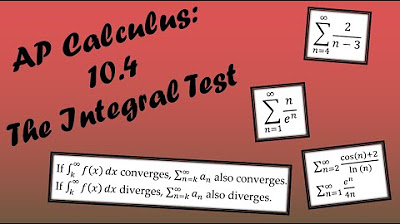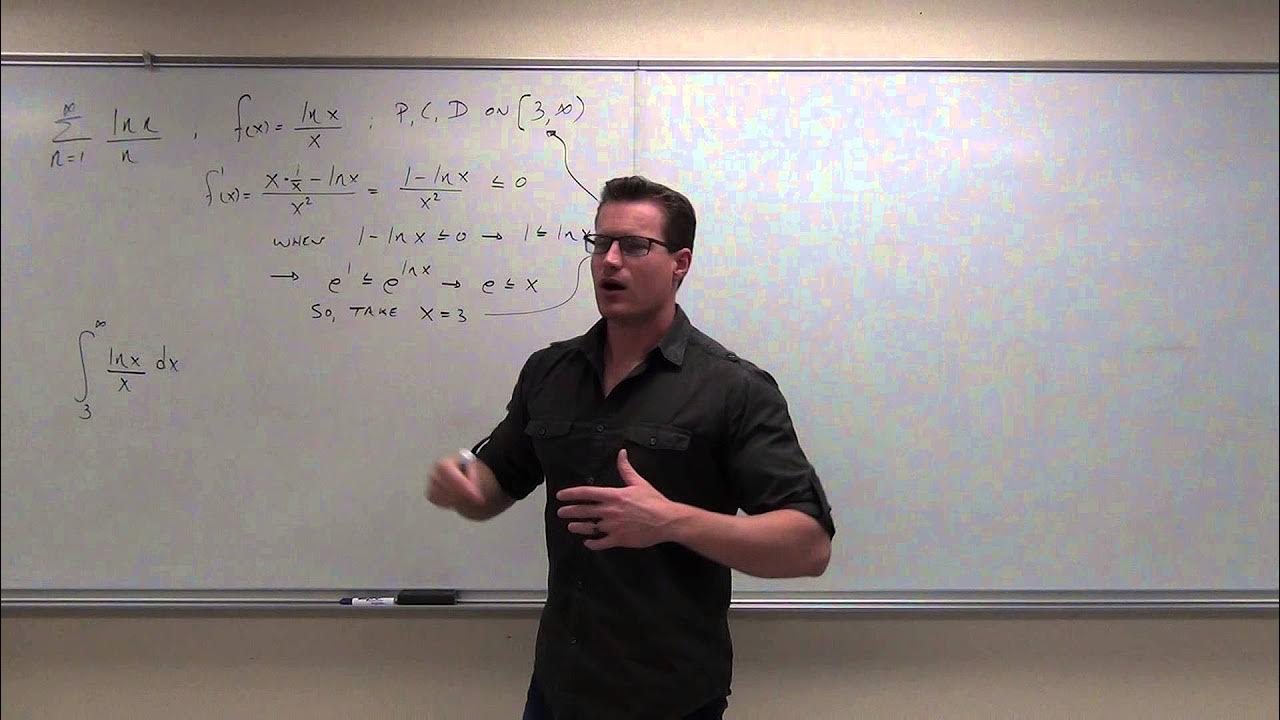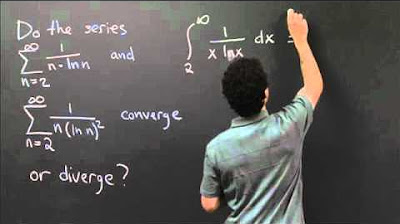Calculus BC – 10.4 Integral Test for Convergence
TLDRIn this calculus lesson, Mr. Bean introduces the Integral Test for Convergence, a method to determine if a series converges by integrating its function. The test is applicable if the function is positive, continuous, and decreasing. The video provides a proof of the test's validity and demonstrates its application with examples, including using u-substitution for integration. It emphasizes the importance of understanding the proof for a solid foundation and highlights that the series and integral either both converge or both diverge.
Takeaways
- 📚 The video is a calculus lesson about the Integral Test for Convergence, taught by Mr. Bean.
- 🔍 The Integral Test is used to determine if a series converges and is applicable if the integral is easy to compute.
- 📉 The function to be tested must be positive, continuous, and decreasing for the Integral Test to be valid.
- 📈 The process involves comparing the series to the integral of the function from a starting point to infinity.
- 📝 If the integral converges to a number, the series also converges; if it diverges, so does the series.
- 📚 The proof of the Integral Test is important for understanding why the test works and is sometimes required for AP tests.
- 📉 The proof involves comparing the series to the integral using left and right rectangular approximations.
- 📈 The series is bounded by the integral from the starting point to infinity, and adding a constant does not change its convergence.
- 📝 The series and the integral must either both converge or both diverge, as shown by the proof.
- 📊 The video includes examples of applying the Integral Test, including checking the conditions for the function and performing the integration.
- 📚 The Integral Test can still be applied even if the function starts by increasing, as long as it eventually becomes positive, continuous, and decreasing towards infinity.
Q & A
What is the Integral Test for convergence?
-The Integral Test for convergence is a method used in calculus to determine whether an infinite series converges or diverges. It involves integrating the function that represents the terms of the series and comparing the result to the series itself.
What are the conditions required for the Integral Test to be applicable?
-The Integral Test can only be applied if the function representing the terms of the series is positive, continuous, and decreasing for all values greater than some positive integer.
Why is the Integral Test considered basic and simple?
-The Integral Test is considered basic and simple because once the conditions are met, the actual process of applying the test involves straightforward integration and comparison of the integral to the series, which can be done relatively quickly.
What happens if the integral from k to infinity of a function converges?
-If the integral from k to infinity of a function converges to a number, then the series formed by the function also converges.
What does it mean if the integral from k to infinity of a function diverges?
-If the integral from k to infinity of a function diverges to infinity, then the series formed by the function also diverges.
Why is it important to understand the proof of the Integral Test?
-Understanding the proof of the Integral Test provides a solid foundation for why and how the test works. It can also be beneficial for answering certain types of questions on exams, such as AP tests, where the proof may be relevant.
How does the Integral Test relate to the series and the integral in terms of convergence or divergence?
-The Integral Test shows that if the integral from 1 to infinity of a function converges, then the series converges as well. Conversely, if the integral diverges, the series also diverges. The series is 'sandwiched' between the integral and the integral plus a constant, and they all share the same convergence or divergence behavior.
What is the significance of the function being decreasing in the Integral Test?
-The function being decreasing ensures that the area under the curve (the integral) is a good approximation for the sum of the series terms. If the function were not decreasing, the areas of the rectangles used in the approximation might not accurately represent the series.
Can the Integral Test be applied if the function starts with a different value than 1?
-Yes, the Integral Test can be applied even if the function starts at a value other than 1, as long as the function is positive, continuous, and decreasing from some point onwards to infinity.
What does the Integral Test imply about the relationship between the series and the integral if both converge?
-If both the series and the integral converge, the Integral Test implies that they converge to the same value, although the series itself does not necessarily converge to the numerical value of the integral.
Outlines
📚 Introduction to the Integral Test for Convergence
In this introductory segment, Mr. Bean presents the integral test for convergence, a method used to determine whether a series converges or not. The test is applicable to series where the function is positive, continuous, and decreasing. The process involves integrating the function from a certain point to infinity and comparing the result with the series itself. If the integral converges to a finite number, the series does as well; if it diverges, so does the series. The importance of understanding the proof is also highlighted, as it provides a solid foundation for the test's application in various problems, including those on AP tests.
📐 Demonstrating the Integral Test with Rectangular Approximations
This paragraph delves into the proof of the integral test, illustrating the concept with a right rectangular approximation. Mr. Bean explains that the series can be seen as the sum of areas of rectangles, which serve as an overestimate or underestimate of the actual integral. By adding a constant to both sides of the inequality and letting n approach infinity, the proof establishes that the integral is bounded by the series and the series plus a constant. This relationship is crucial as it shows that the series and the integral either both converge or both diverge. The explanation is accompanied by a visual representation of the function and the integral, emphasizing the importance of verifying the conditions of positivity, continuity, and decreasing nature of the function.
📘 Applying the Integral Test with Examples
In this final segment, Mr. Bean applies the integral test to specific examples, demonstrating how to determine the convergence of a series using the test. He first checks the necessary conditions for the function: positivity, continuity, and decreasing nature. Then, he sets up the integral and evaluates it as the limit approaches infinity. The examples show how the integral's convergence or divergence directly informs the series' behavior. It's clarified that while the integral may converge to a certain number, the series converges but not necessarily to the same value. The video concludes with a note on the applicability of the integral test even when the function starts by increasing, as long as it eventually becomes positive, continuous, and decreasing towards infinity.
Mindmap
Keywords
💡Integral Test for Convergence
💡Series
💡Convergence
💡Divergence
💡Positive Function
💡Continuous Function
💡Decreasing Function
💡Rectangular Approximation
💡Limit
💡U-Substitution
💡Natural Logarithm
Highlights
Introduction to the Integral Test for Convergence, a method to determine if a series converges by integrating its terms.
The Integral Test is applicable only to series with terms that are positive, continuous, and decreasing.
Explanation of how to apply the Integral Test by integrating the function from a constant to infinity and comparing it to the series.
If the integral converges to a number, the series also converges; if the integral diverges, so does the series.
The importance of understanding the proof behind the Integral Test for a solid mathematical foundation.
Demonstration of setting up the Integral Test using an exponential decay function that meets the criteria of being positive, continuous, and decreasing.
Illustration of the left and right rectangular approximation methods to estimate the area under the curve and its relation to the series.
Proof that the series is bounded by the integral from 1 to infinity of the function, plus or minus a constant.
The series and the integral either both converge or both diverge, as shown in the proof.
Examples of applying the Integral Test to series, including checking the conditions for positivity, continuity, and decreasing nature.
Use of u-substitution in integration to simplify the process of applying the Integral Test.
The divergence of a series is confirmed when the integral also diverges to infinity.
The convergence of a series is established when the integral converges to a finite number.
Clarification that the series may converge without necessarily having the same sum as the integral.
Discussion on the application of the Integral Test even when the function starts by increasing, as long as it eventually becomes positive, continuous, and decreasing.
The Integral Test's utility in conjunction with other series tests like the nth term test and geometric series identification.
Encouragement to practice the Integral Test alongside other series tests for mastery.
Transcripts
Browse More Related Video

AP Calculus BC Lesson 10.4

Calculus 2 Lecture 9.3: Using the Integral Test for Convergence/Divergence of Series, P-Series

Worked example: Integral test | Series | AP Calculus BC | Khan Academy

Integral Test | MIT 18.01SC Single Variable Calculus, Fall 2010

Calculus BC – 10.8 Ratio Test for Convergence

Calculus Chapter 5 Lecture 51 Convergence Tests 1
5.0 / 5 (0 votes)
Thanks for rating: